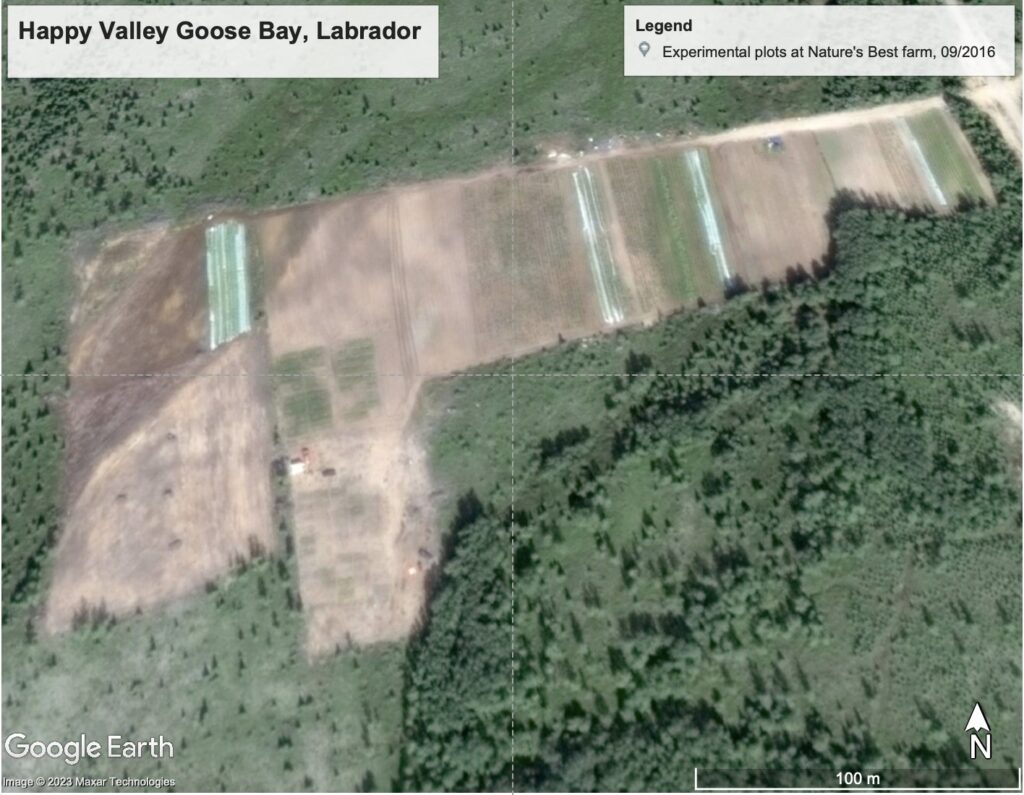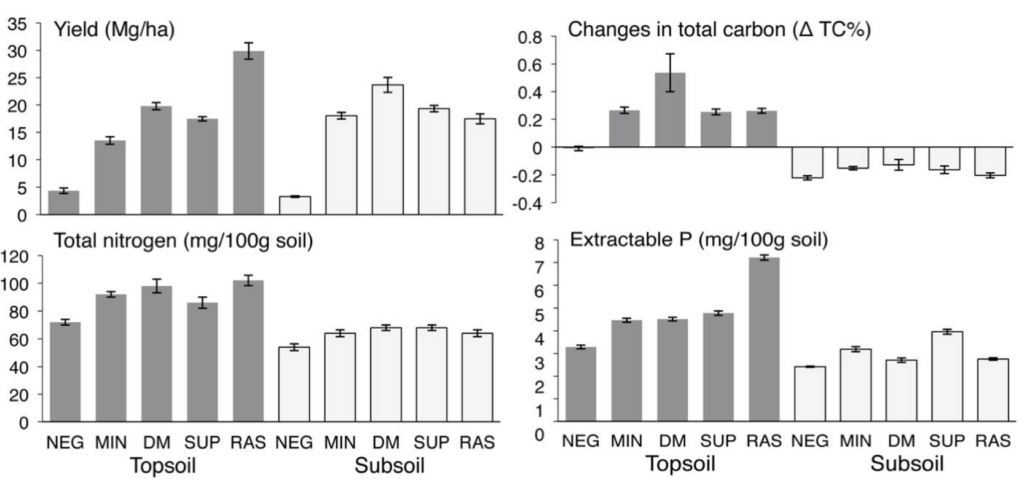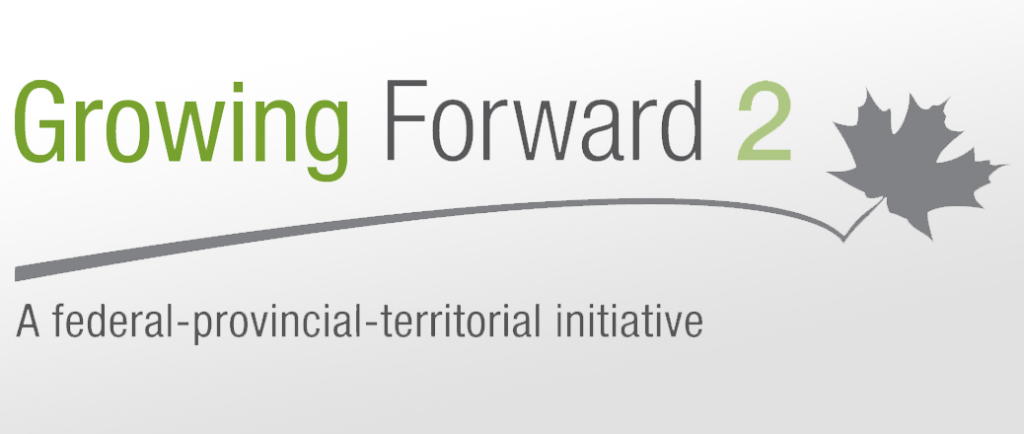Farms in the northern cold-climate regions of Canada are: (1) small (<100ac) and thus not amenable to large scale farming protocols; (2) are established either on less fertile soils that require significant management to maintain soil carbon (C) and related soil functions; or (3) on soils that are perceived as fertile mainly due to the nutrients freed by rapidly mineralizing soil organic C; this C is easily lost and fertility declines; (4) are in direct contact with the natural ecosystem, allowing for exchange of nutrients, and for interactions between soil biota across the natural/managed divide (i.e., similar, but yet to be quantified, to agroforestry systems); and (5) farms are spread across a large geographical area, from Labrador to Yukon. However, while farmers are already implementing a range of innovative approaches, directly or indirectly relevant to 4R Nutrient Stewardship concepts (e.g., regenerative farming, organic farming practices, re-use of local organic waste streams to enhance fertility of marginal soils, strip-cropping and intercropping, crop-rotation, biochar, etc.), there are no objectively verifiable, locally calibrated tools to evaluate their impact on the long-term sustainability of soil fertility and soil health. Inappropriate fertilization rates and schedules cause unforeseen changes in C (e.g., microbial respiration) and nutrient cycling (nitrification, denitrification) leading to increase in greenhouse gas emissions and low fertility. Nutrient budgeting is critical for soil health and related functions, including C speciation and sequestration. A balanced soil biogeochemical cycle also reduces negative impacts on biodiversity, including that of adjacent undisturbed ecosystems. Establishment of C friendly practices requires (1) a thorough understanding of the impact of management options on soil fertility and soil health characteristics including nutrient budgeting; (2) a verifiable approach to quantify C and its (long-term) stability; and (3) rapid dissemination of knowledge, including success stories and encountered impediments. The geographical spread across numerous jurisdictions currently hampers knowledge mobilization among farmers and farming communities.
Soil Amendment with Biochar for Increased Crop Productivity and Enhancement of Soil Fertility in the Sandy Soils of Labrador (led by Dr. Joinal Abedin)
(i) effect of biochar when applied singly or in combination with fishmeal and chemical fertilizers;
(ii) the effect of different application rates of biochar
iii) micronutrient supplying capacities of biochar.
iv) response of soil nematode communities to biochar amendments
Labrador field research site: Nature’s Best farm


Plant uptake based assay of nutrient stoichiometry for fish hatchery waste
Most nitrogen in recirculating aquaculture systems (RAS) waste in the liquid phase is found as ammonium, with negligible nitrate-N. However, the waste’s low pH, of about 5-6, likely does not favour ammonia volatilization and it is likely immediately available to plants. Salinity and heavy metal concentrations are likely not a concern. It is hypothesized that nutrients are made available to plants both in immediately available forms and during growth, via mineralization. The latter can make P plant-available after waste is added to soils; delayed availability of mineralizable N is more accurately accounted by the type of N compounds, e.g. proportion of protein, as opposed to a simple C:N ratio. One may thus employ a plant cultivation assay to elucidate the capacity of RAS waste-based mixes to effect changes in soil fertility parameters and affect nutrient use efficiency kinetics; therefore a stoichiometric assessment based on elemental balances in the plant and soil system can be employed to assess nutrient availability as reflected in plant assimilation.
Questions:
Impact of fertiliser source on the dynamics of carbon and nutrients in a Podzol designated for land-use conversion
RAS impact of soil layers of a converted boreal soil on tall fescue biomass stoichiometry and residual soil nutrients
RAS impact of soil layers of a converted boreal soil on soil carbon storage
Results:
- The management of a converted podzolic soils in the circumboreal regions does need to account for the initial status of the soil mixing.
- Initial good responses to fertilization might be misleading and it does not necessarily mean that the soil can easily sustain productivity over longer term.
- Distinct organic fertilizers did clearly behave distinctly for the two soils of arguably equivalent fertility as indicated by standard far soil tests; detailed insights into the functional status of soil microbiomes for converted podzolic soils are clearly necessary to devise management tools that can sustain long term fertility build-up and sustainability of nutrient management.
From a practical point of view these results also raise the question of management advising. Immediate response to fertilization might be seen as a positive by farmers but this might challenge long term sustainability concerns. These questions can be only answered with long term, comprehensive agronomic experiments.
If the purpose or function of the soil is to retain OM, then the type of fertilizer and carbon rich supplements must be tailored to the age of the land after clearing.

Tall fescue yield, total soil nitrogen (mg/100g dry soil), Olsen Extractable soil P (mg/100g dry soil), and changes in soil total carbon (Δ TC%) at the conclusion of experiment: DMN, dairy manure; MIN, mineral fertilizer; Neg, negative control; RAS, recirculating aquaculture solids; SUP, recirculating aquaculture solid tank supernatant.
Results:
Funding:





